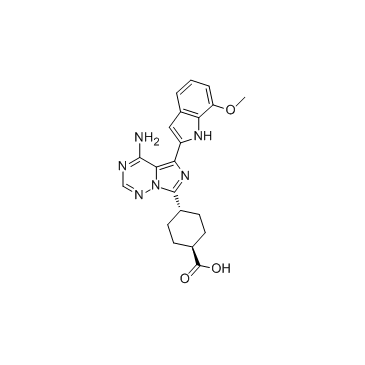936890-98-1
| Name | 4-[(5Z)-4-amino-5-(7-methoxyindol-2-ylidene)-1H-imidazo[5,1-f][1,2,4]triazin-7-yl]cyclohexane-1-carboxylic acid |
|---|---|
| Synonyms |
K1146_Kinasechem
Cyclohexanecarboxylic acid, 4-[4-amino-5-(7-methoxy-1H-indol-2-yl)imidazo[5,1-f][1,2,4]triazin-7-yl]-, trans- cc-501 Cyclohexanecarboxylic acid,4-(4-amino-5-(7-methoxy-1H-indol-2-yl)imidazo(5,1-f)(1,2,4)triazin-7-yl)-,trans 4-[(5E)-4-Amino-5-(7-methoxy-2H-indol-2-ylidene)-1,5-dihydroimidazo[5,1-f][1,2,4]triazin-7-yl]cyclohexanecarboxylic acid OSI-027 trans-4-[4-Amino-5-(7-methoxy-1H-indol-2-yl)imidazo[5,1-f][1,2,4]triazin-7-yl]cyclohexanecarboxylic acid S2624_Selleck Cyclohexanecarboxylic acid, 4-[(5E)-4-amino-1,5-dihydro-5-(7-methoxy-2H-indol-2-ylidene)imidazo[5,1-f][1,2,4]triazin-7-yl]- UNII-25MKH1SZ0M |
| Description | OSI-027 is an ATP-competitive mTOR kinase activity inhibitor with an IC50 of 4 nM. OSI-027 targets both mTORC1 and mTORC2 with IC50s of 22 nM and 65 nM, respectively. |
|---|---|
| Related Catalog | |
| Target |
mTORC1:22 nM (IC50) mTORC2:65 nM (IC50) mTOR:4 nM (IC50) PI3K-γ:0.42 μM (IC50) PI3K-α:1.3 μM (IC50) DNA-PK:1 μM (IC50) Autophagy |
| In Vitro | OSI-027 is an ATP-competitive inhibitor, which targets both mTORC1 and mTORC2 with IC50s of 22 nM and 65 nM. OSI-027 also inhibits PI3K-α, PI3K-γ and DNA-PK with IC50s of 1.3 μM, 0.42 μM and 1.0 μM. OSI-027 inhibits mTOR signaling of phospho-4E-BP1 with an IC50 of 1 μM[1]. |
| In Vivo | Effects on GEO colorectal xenograft growth treated with Rapamycin or OSI-027 for 12 days are consistent with our in vitro experiments. Treatment with Rapamycin (20 mg/kg) inhibits phospho-S6 and phospho-4E-BP1, while Akt phosphorylation is increased by 29%. In contrast, OSI-027 (65 mg/kg) inhibits both mTORC1 and mTORC2 effectors. After 2 hours, decreased 4E-BP1, Akt, and S6 phosphorylation is observed and inhibition of S6 and Akt is sustained for 24 hours. The plasma drug concentration of OSI-027 inversely correlated with these effects on mTORC1 and mTORC2 signaling. The median plasma drug concentration with OSI-027 is 21.3 μM at 2 hours and 14.9 μM at 8 hours. The in vivo efficacy of OSI-027 plus Sunitinib is tested in H292 human lung and Ovcar-5 human ovarian xenograft tumors. H292 tumors, treated with OSI-027 (50 mg/kg) for 21 days have 61% median tumor growth inhibition for the duration of treatment (TGI). Sunitinib (40 mg/kg) for 21 days had 47% median TGI. Combining OSI-027 with Sunitinib, however, has a median TGI of 100% with 59% maximal tumor regression, a statistically significant improvement over either agent alone. Ovcar-5 xenograft tumors treated with OSI-027 or Sunitinib have a 55% and 68% median TGI, respectively. OSI-027 administered with Sunitinib has a significantly better median TGI of 100% with 38% maximal tumor regression[1].In the Rapamycin (RAPA) group, three rats exhibit symptoms typical of LTx-aGVHD and die 27 to 35 days after liver transplantation (LT); the remaining five rats do not develop LTx-aGVHD symptoms and survive for more than 100 days. In contrast, seven rats in the OSI-027 group survive for more than 100 days without symptoms of LTx-aGVHD, and only one rat exhibits LTx-aGVHD symptoms and dies on day 33 after LT[2]. |
| Kinase Assay | Assays of a panel of 40 other recombinant kinases including both protein and lipid kinases are performed at 100 mM ATP concentration by SelectScreen profiling service. A broad panel of kinases is tested at a single concentration of OSI-027 or OXA-01 (3 μM) to evaluate percent inhibition of each kinase or mutant variant, using the Ambit KinomeScan platform[1]. |
| Cell Assay | To study the effect of drug treatment on cellular signaling, Ovcar-3 cells are plated in normal growth medium. After 24 hours, serum is removed and cells are serum-starved overnight. Rapamycin, OSI-027 and OXA-01 are solubilized in DMSO and added to cells at varying concentrations. After a two-hour incubation cells are growth factor stimulated with 10 ng/mL Insulin for 3 to 5 minutes, then rinsed with cold PBS and lysed[1]. |
| Animal Admin | Mice[1] For xenograft models, cells are harvested, implanted s.c. in the right flank of nu/nu CD-1 mice and tumor growth is analyzed. Mice bearing GEO xenografts are treated for 12 days with OSI-027 (65mg/kg) or vehicle and tumors collected at 2, 8, and 24 hours. Tumor growth inhibition and regression calculations are included. Rats[2] Specific pathogen-free female Lewis rats, male BN rats, male Lew-Tg(CAG-EGFP)YsRrrc rats and male Lew-TgYsRrrc rats are used. Orthotopic LT is undertaken. No antibiotics were used. Freshly prepared splenocytes (4×108, suspended in 500 μL PBS) of Lew-Tg YsRrrc rats are infused into each recipient via the dorsal penile vein immediately after LT (within 30 min). LTx-aGVHD model rats are divided into three experimental groups: RAPA (1 mg/kg), OSI-027 (1 mg/kg) or control (equal quantity of vehicle) groups; treatments are administered via the vena caudalis from day 7 to day 15. |
| References |
| Density | 1.6±0.1 g/cm3 |
|---|---|
| Boiling Point | 591.4±60.0 °C at 760 mmHg |
| Molecular Formula | C21H22N6O3 |
| Molecular Weight | 406.438 |
| Flash Point | 311.5±32.9 °C |
| Exact Mass | 406.175354 |
| PSA | 131.42000 |
| LogP | -0.37 |
| Vapour Pressure | 0.0±3.6 mmHg at 25°C |
| Index of Refraction | 1.788 |
| Storage condition | -20℃ |
